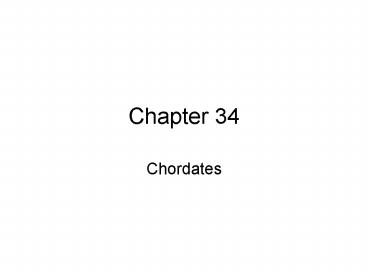Chordates - PowerPoint PPT Presentation
1 / 27
Title: Chordates
1
Chapter 34
- Chordates
2
Phylum Chordata
- characterized by animals that possess at some
point in their lives a notochord, a dorsal nerve
cord, and _______ pouches. - The ______________is later modified into a hard
bony backbone - The ________________ is a hollow tube that will
later become modified into a spinal cord and
brain - The ___________ pouches will later modify into
ear and throat parts or gills
3
Two living ancestors
- Urochordata _______ shaped tunicates
- _______ salt water
- Nickname __________
- Cephalocordata __________
- Scaleless fish-like
4
(No Transcript)
5
Agnatha Jawless Fishhad circular mouths
- _____________ - slimy
- ____________
- Mouth has hooks and
- strong sucker with __________-like tongue
- _________ covered in mucus
- ______________
- Enter dead fish and
- eat the insides
6
Vertebrates
- Amphibians, fish, reptiles, birds, mammals
- Have a true _____________
- ____________ is replaced by a bony vertebral
column - A protective bone (__________/skull) covers the
brain - Possess an ______skeleton which allows them to
grow larger than all other phylum of animals
7
Fish
- Over ______ of all vertebrates are fish
- Breathe through ________
- Blood circulation is in a single-loop and flows
_________________ with the water
8
Cartilaginous Fish
- Sharks skates, and rays
- Skeleton is made of _____________ not bone
- Most have remained unchanged for _____________of
years - They were the first vertebrates to develop teeth
(from their ___________) and jaws (from their
______________) - Sharks stay buoyant using an ____________
- Have special pits in their snout called
________________ to pick up electrical signals - Most use _____________________ to breathe
9
(No Transcript)
10
(No Transcript)
11
(No Transcript)
12
____________
13
(No Transcript)
14
Bony Fish
- Endoskeleton made of bone
- Stay buoyant using a __________________ which is
inflated and deflated with ______ - Both sharks and bony fish have a ______________
with sensory pits to detect mechanical waves in
the water - Bony fishs gills are protected by an outer hard
shield called the ______________ - Have __________ in most fins
- Fins without spines are called ___________ fins
- Most use _______________ pumping to breathe
15
(No Transcript)
16
Amphibians
- Frogs, toads, salamanders, _________, and the
caecilian of South America - Fish that could breathe out of land for long
periods of time evolved into amphibians - Most have legs the _____________ is legless
- Can breathe (diffusion) directly through their
moist skin _____________ respiration. - First animal to develop a lung no __________
- ____chambered heart is partially divides
oxygenated blood from deoxygenated blood - reproduction is external and must take place
near water eggs are jelly-like and permeable to
________
17
(No Transcript)
18
Reptiles snakes, lizards, turtles, tortoises,
crocodilians, tuataras
- Evolved from amphibians
- Developed a waterproof skin by using the
protein ___________ to fill their epidermal cells - First to have real __________
- First to have ___________ water-tight eggs to
conserve water
19
______________ organ located on the roofof the
mouth - senseschemicals taste the air
20
(No Transcript)
21
(No Transcript)
22
Birds
- Evolved from reptiles as did mammals
- Possess ___________ skin and shelled eggs like
reptiles - Warm blooded
- have feathers
- ________- warmth
- ______ streamline
- shape and colors
- flight flight
- Large ______ for
- pectoral attachment
23
Bird heart
- Highest heart rate of any animals
- Very efficient ____ chambered heart that keeps
blood from mixing - Highly adapted lungs with many ________
24
Types of birds
- Long _____ wading
- Birds of _______
- __________ birds
- _______ birds
- ______ birds
- _____
25
Mammals
- Only animals to have _________
- Warm blooded
- Secrete milk from ____________ glands
- Have specialized _______ (canines, incisors,
molars) - Placental carry their young in a _________ and
nourish them through a blood rich tissue called
the placenta - Marsupials carry their young in a _________
- Monotremes _____________ mammals
- 4 chambered heart __________ separates cavities
26
Placentals Marsupials
27
Monotremes































